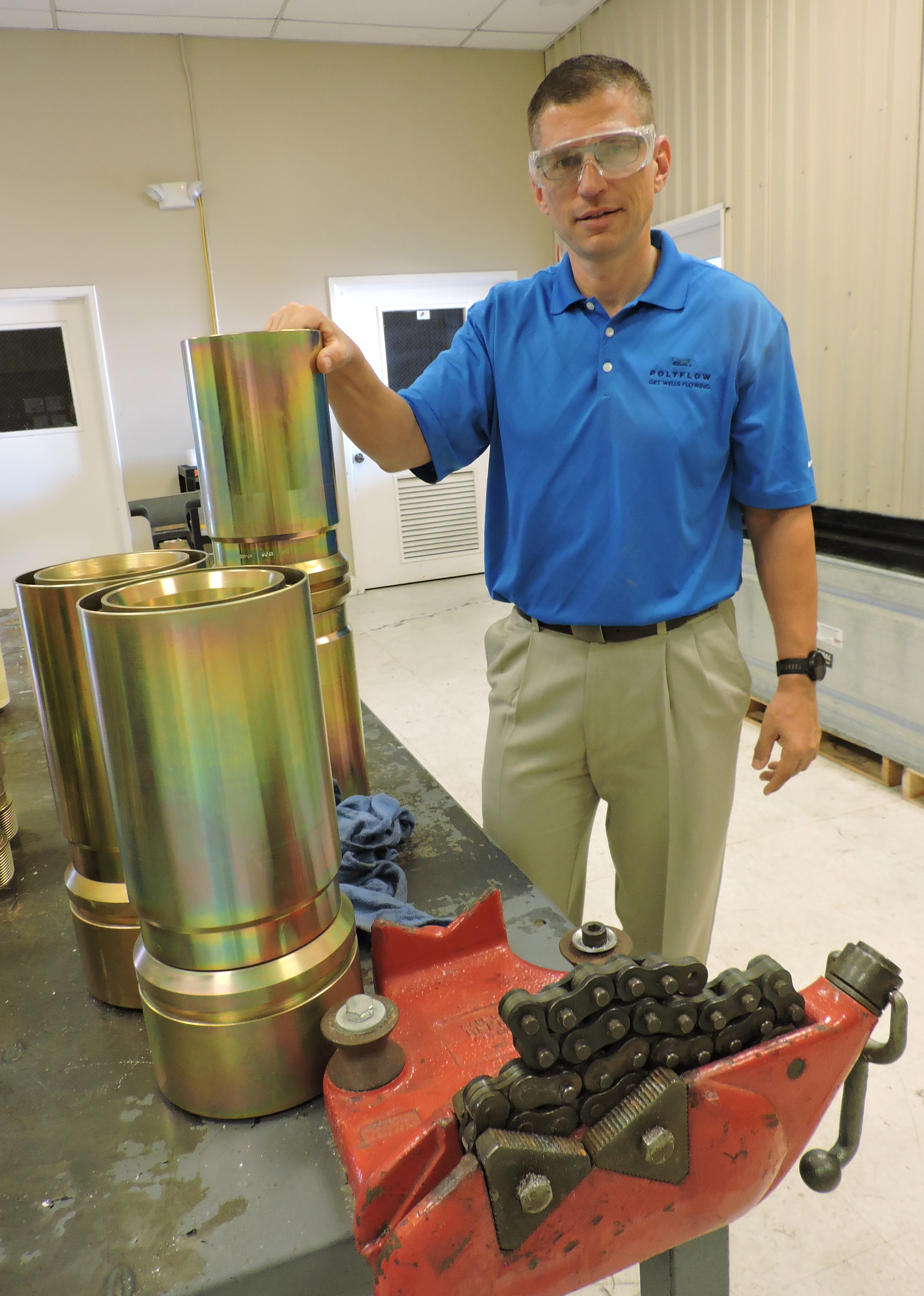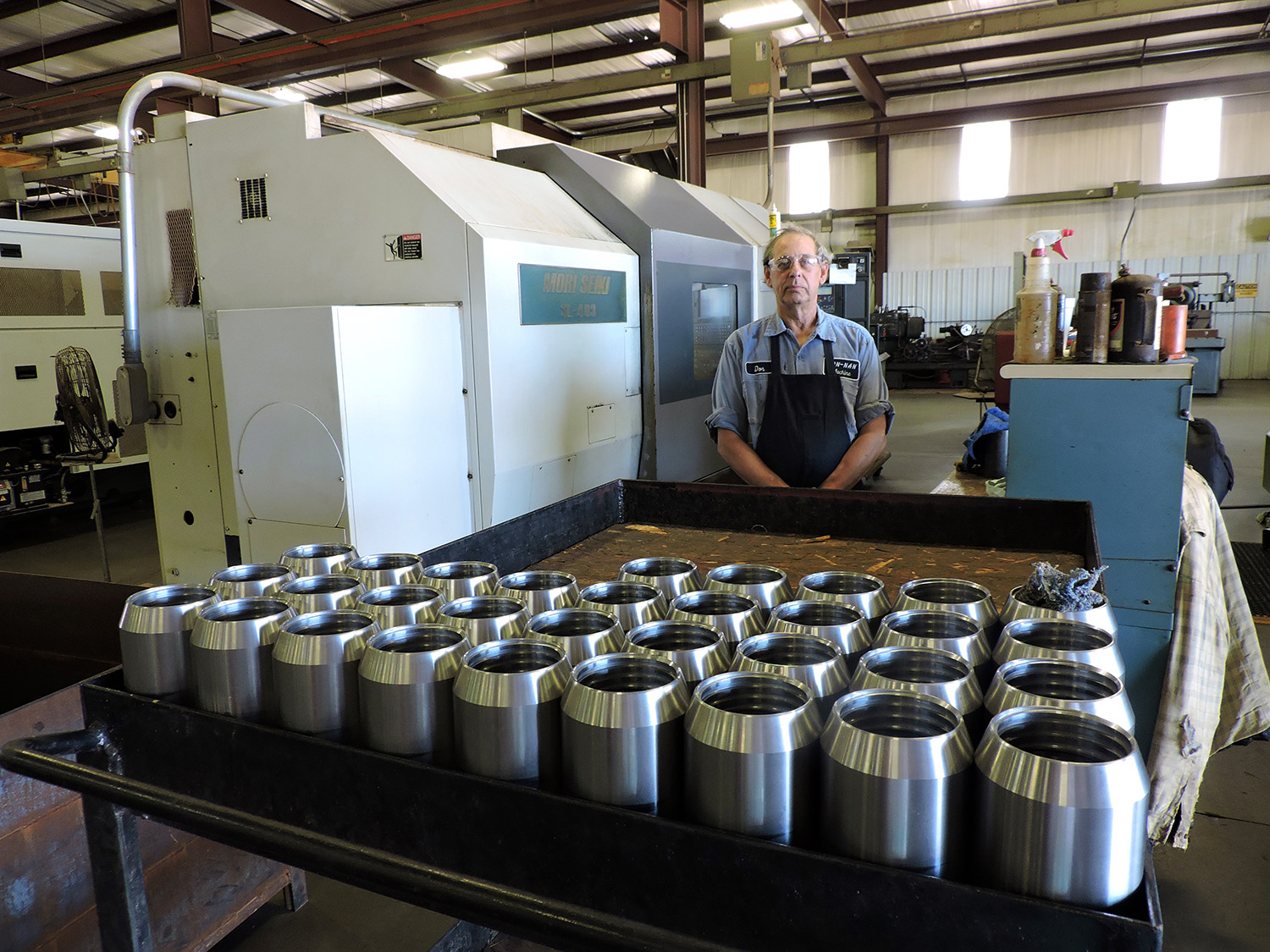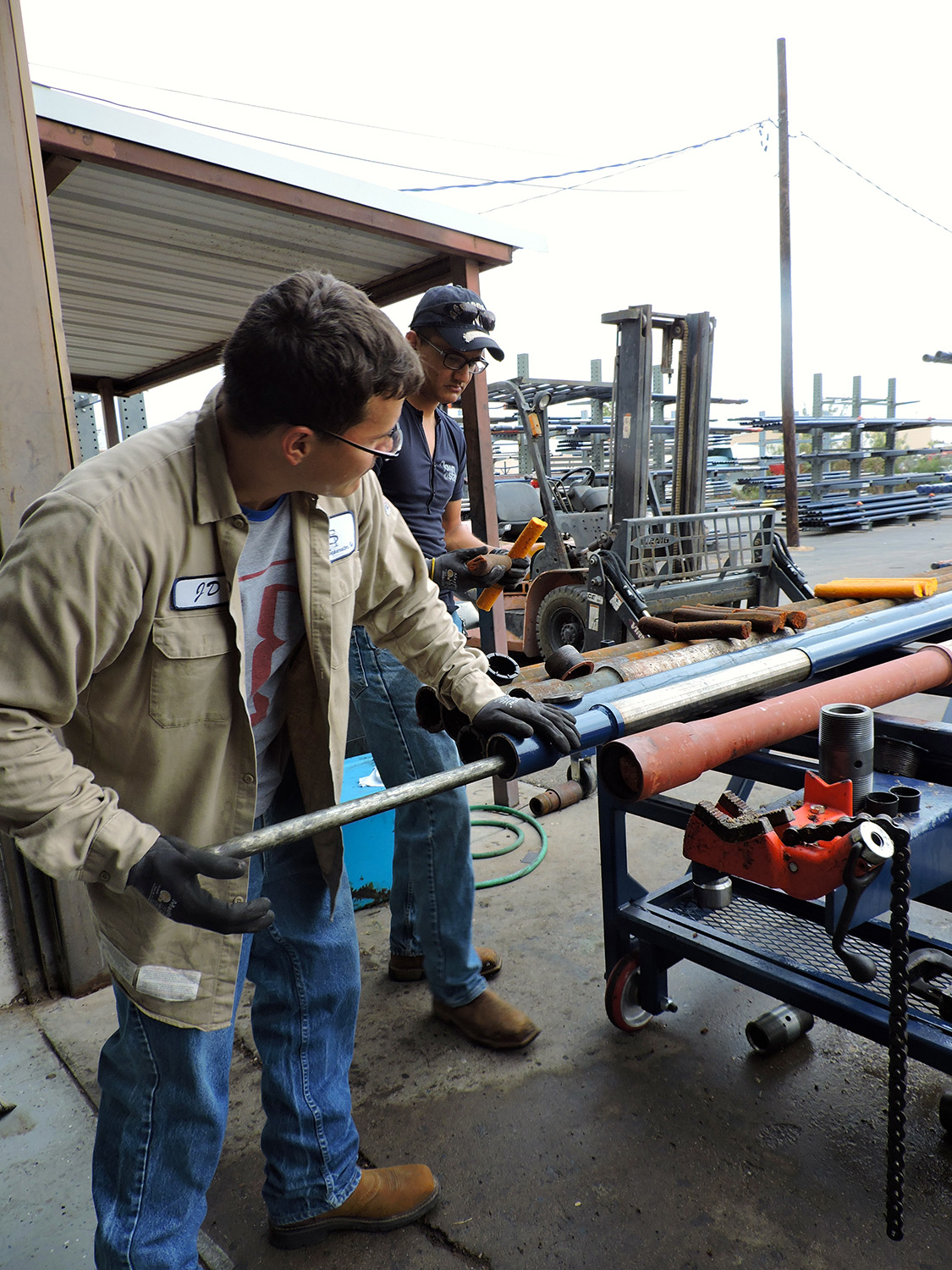Story and photography by Hanaba Munn Welch
The Permian Basin is a natural place for manufacturing products to meet the needs of the oilfield—a part of the world where necessity spawns inventiveness as surely as the aromas of the mother lode waft faintly in the breeze.
Three manufacturers of different products for the industry opened their doors to PBOG in mid-August for interviews and pictures of their operations. They’re not the only players in the manufacturing world of the Permian, but each has a story to tell and products to promote with pride, despite the current downturn in the industry.
Polyflow
“Brewed in the back yard,” is how Polyflow’s Jeremy Hohn talks about Thermoflex Lite pipe, albeit with poetic license. Hohn is U.S. director of sales for Polyflow, manufacturer of Thermoflex and Thermoflex Lite spoolable pipe.
It’s a colorful image, but mad scientists didn’t gather around a bubbling caldron in a corner of the yard to whip up the formula for Thermoflex Lite, the company’s newest line of spoolable pipe. Rather, the standard was already in place—ASTM standard F-2807, by name.
“Nobody wanted to explore the manufacturing process to bring it to market,” Hohn said. “The recipe was out there but never mastered and executed until now. We had already mastered nylon with the Thermoflex product. This seemed like a natural next step. We realized the application we could service in the oil industry from our experience.”
As if to confirm the viability of Thermoflex products, Hohn paused his interview with PBOG to take a phone call from a potential customer. His side of the conversation, unavoidably eavesdropped, tells how Polyflow works with customers interested in their products:
“We hold your hand the first few days,” Hohn told the caller. “We certify you. The training [for installation] takes two to three days. We teach you how to use the splice machine, to check for the integrity of connections, what you should and shouldn’t do for deployment, how the deployment trailer works. All that overview training is in the first two to three days on the first installation.”
Hohn answered questions about the process for connecting lengths of standard Thermoflex pipe:
“It’s a little bit different animal. There’s no heat fusion. It’s a crimping process,” he said. Thermoflex Lite, to the contrary, can be either crimped or fused.
Absent the day of the interview for good reason was CEO Jim Moore, who had made a trip to Alabama to work with a major client on rehabilitating a pipeline. The Alabama rehab job involved pulling pipe off reels through existing steel to restore the integrity of an existing eight-inch aged pipeline, Hohn said. “We literally do projects all around the world,” he said. “But we put our flag in Midland.”
The company didn’t begin in Texas and the oilfield hasn’t always been the focus. “Polyflow was established in 2002 in Oaks, Pennsylvania,” Hohn said. “Two chemical engineers had decided to work on a pipe for gas stations… corrugated nylon pipe to run under filling stations.”
But the greater opportunity was the Permian and the question became how to make it oilfield applicable. “We needed to give it more strength,” Hohn said. “We settled on aramid fiber. It’s the same thing used in bullet-proof vests.”
One of Hohn’s favorite things to do at trade shows is to give people a chance to take handles in hand to break a puny-looking strand of aramid strung between them. “Go ahead and snap this,” he tells them. “I’ll give you $100 cash.” So far he’s kept his money.
That said, the new Polyflow product—Thermoflex Lite—isn’t reinforced with aramid. Designed for transporting hydrocarbons at low pressures—up to 300 psi—the high-density polyethylene (HDPE) pipe utilizes a nylon inner liner, co-extruded with the HDPE in the manufacturing process. Thermoflex Lite is a suitable and more cost-effective solution than Thermoflex (subject of the above-mentioned phone conversation) for many customers, depending on their needs.
“We didn’t see anybody else in the industry utilizing this window,” Hohn said.
Polyflow manufactures both Thermoflex and Thermoflex Lite at its plant in Midland. The company not only offers training in how to deploy both types of pipe but also will perform the installation if it’s the customer’s preference. “We actually deploy at a competitive rate,” Hohn said.
Steel has always been the industry standard, but spoolable reinforced thermoplastic pipe has found a place in the oil and gas world, and Polyflow isn’t the only player. In the competitive environment, flexibility is the watchword at Polyflow—not just for the product (which rolls up nicely onto big steel truck-able reels), but also for the company’s readiness to meet to industry needs. “Polyflow could respond to needs elsewhere if another plant is needed,” Hohn said. “We could have one up and running in less than a year.”
But for now, it’s a matter of Made in Midland.

Aramid fiber reinforces Polyflow’s Thermoflex spoolable pipe. Holding a spool is Jeremy Hohn, U.S. director of sales for the company.
Don-Nan Pump and Supply
Across I-20 in the same industrial neighborhood, Don-Nan Pump and Supply fills a more traditional role in the oil and gas industry, manufacturing sucker rod pumps virtually lock, stock, and barrel. In fact, Don-Nan does make the barrels. It’s easier to say what parts of a pump Don-Nan doesn’t make. “The only things we don’t manufacture on the pump are balls, seats, and seating cups,” said Tyler Fowler, marketing manager.
Don-Nan, acquired at the end of 2014 by oilfield service giant Schlumberger, is the only rod pump company in the Schlumberger line-up.

Don-Nan Pump and Supply machinist Don Moran stands behind a collection of Baker style lower cones. Moran deburrs the component at the Don-Nan manufacturing facility in Midland.
In PBOG’s August issue, in an article by Paul Wiseman on challenges facing generator, compressor, and pump companies, Fowler mentioned a Don-Nan product that is made of anything but steel: software. It’s worth mentioning again because Don-Nan’s software is an indicator of how the industry is changing via computerization, specifically digitization. It’s a process Don-Nan uses to keep records on the pumps it manufactures and the wells they serve. “All pump companies keep records on repair of their pumps,” Fowler said. “We introduced a digitized version. We can pull from everywhere within our data base.”
Don-Nan doesn’t just manufacture pumps. Repairs are part of the business too. A sample scenario described by Fowler: “We sell a new pump. In six months to a year, the pump might be damaged. They pull the well. They send us the pump. We take it apart. We build a whole new pump, if that’s what they want.”
But beyond repairing the pump, Don-Nan catalogs the conditions discovered, even taking pictures. “They can log in, and they can look at their specific well and look at the pumps as long as we’ve been doing the work,” Fowler said.
If the well changes ownership, the records remain, meaning the new operator is more likely to stick with Don-Nan than to switch to a different company for pump service. “It’s an added advantage if it’s with us,” Fowler said. “They have a history.”
Don-Nan’s pump tracking software integrates directly with the company’s invoicing system, making it easy to match the pumps to the wells and their operators and to reassign the data if and when wells change hands. It’s a software Don-Nan has marketed as a stand-alone product, although Fowler would say no one has put the system to better use than Don-Nan.
Regarding Don-Nan’s manufacturing complex, the floors gleam almost as much as the finely machined pump parts stacked and racked in all directions. It’s a clean operation with three areas serving three aspects of the manufacturing process. Machinists in the machine shop make small parts. The hone shop is where tubing is straightened and otherwise prepared for use. Plungers are ground, straightened, and polished in the plunger facility.
Chrome plating is a process that happens elsewhere—previously by another company and now in-house at a chrome plating plant in Temple. “Chrome is a common coating on a lot of things that we do,” Fowler said. “It helps with abrasion.”
In the grand Schlumberger scheme, Don-Nan is just one small part of a big picture. “We’re one piece of the puzzle,” Fowler said.
But a key piece—Schlumberger’s rod pump company.
Don-Nan employs 275 employees. The previous owner, Don Carruth (son of founder Vernon Carruth) is now president. The ownership change has been a smooth one with a few Schlumberger employees moving to Don-Nan to help integrate the smaller company into the larger one and to adjust to the enhanced pursuit of international markets. “Some different parts of the world use drastically different pumps,” Fowler said.
Whatever design is required and whatever the location of the well, halfway around the world or somewhere in Ector County, Don-Nan has the know-how to manufacture the pump and keep track of how well it works, all in Midland, Texas.
OSI—Odessa Separator
By any other name, OSI is Odessa Separator, but the company is changing its name to its initials. It’s a better name for a company that has expanded its product line beyond separators.
Based in Odessa, OSI has been building a reputation for itself the last few years for its innovative systems to deliver solid chemicals to treat fluids below the pump intake. That’s not to mention the OSI line of filtration sand screens.
In what he calls his “stump speech,” Bert Frost, chief executive officer, summarizes the aim of OSI: “We specialize in fluid control prior to artificial life, whether it be filtration, gas separation, or chemical delivery. It’s our three-core product line.”
In the Permian Basin context, OSI stands out for the scope of what it manufactures—not just the products but some of its own manufacturing equipment as well. “Some of our machines are really unique, and we’ve had to learn how to not only operate the machines but to build them from the ground up,” Frost said.
Despite hard times in the industry, OSI is expanding, moving from its buildings on South Viceroy Avenue to a larger 11-acre manufacturing facility on Pearl Street. “That will bring us all under one roof,” Frost said. “The downturn is a good opportunity for us to make these changes. We are investing in the future.”Frost wouldn’t say that OSI is thriving through these down times, but he obviously expects the company to survive. OSI isn’t just expanding its facility but is also adding a new division: technical services.
“We spec out downhole equipment,” Frost said. “How to set up the well bore, the BHA [bottom hole assembly], where to place the pump in relation to the perfs. A lot of people appreciate that additional service. We’re trying to add value on top of what we say—‘kick the tool off.’ [A reference to driving up to a location, kicking the customer’s tool off the truck, and driving away.] We’re trying to add value beyond selling a product. We want to sell an engineered solution for the customer. This has been a major focus of our company during this downturn—putting in a technical services department that is able to deliver.”
Frost quotes an adage that sums up the value of the new department: A good tool with the wrong application gives you a bad ending.

Genaro Ramos, assistant chemist at OSI, places two sticks of chemical on a tray at the OSI complex on South Viceroy Avenue in Odessa. In the works for OSI is relocation to a much larger facility on Pearl Street. The sticks are for placement downhole.
OSI, Frost would say, is where solutions and ideas get worked out around a table, sometimes starting with the wrong idea to get to the right one. “We can have bad ideas,” he said. “You’re just not allowed to sit around the table and not have any ideas. We create a lot of tooling and a lot of engineering solutions for our customers. There’s a synergy when we work with our customers. We’re able to come up with some new products.”
Besides pride in what OSI has been able to accomplish, Frost is just as quick to point to his major shortcoming: dyslexia. But he believes his deficiency has made him recognize the importance of finding people with different strengths to be part of the OSI team. “I know I’m extremely dyslexic,” he said. “A lot of dyslexics feel like underdogs in society. The flip side of that, I have just realized quickly that you have to have other people to round out your skill sets.” Frost struggled in school, feeling like “a square peg in a round hole.”
“I have learned there’s some value in realizing you’re not a complete package,” he said. “It makes you focus on the power of other people.”
A tour of the workplace gives anyone a chance to see that OSI employees seem to like what they’re doing. “We do have a good culture,” Frost said.
The attitude of Neil Turner, machinist, sums things up. “Most of us are still here,” Turner said. “We’re ready when it picks back up again.”
OSI’s chemical tools for downhole fluid treatment are probably the company’s most interesting innovation. The inner chemical sticks release chemicals downhole similar to time-release medication used in the pharmaceutical industry. The result is the prevention of corrosion and the build-up of scale and paraffin, among other detrimental agents downhole. It’s an innovative system patented by OSI.
The chemicals are encapsulated in treatment sticks inserted in perforated tubes placed below rod pumps, ESPs, in gas lift wells, plunger lift wells, or even in flowing wells.
Comparing the chemical sticks to large sausages is hard to avoid. An OSI machine literally cranks them out sausage-fashion. The sticks come in different varieties, each formulated to treat a different problem. The stick that covers the widest spectrum of conditions carries the nickname “silver bullet.”
The chemical department is eager to get into the new lab that will be part of the new facility.
During the PBOG plant tour, Genaro Ramos, assistant to the chief chemist, was working at the machine that forms the sticks, one of his previous jobs. “This is where I started,” he said. “This is where they need me.”
He doesn’t mind literally cranking out the product. “This is my baby,” he said.
Ramos likes to talk about the process.
OSI uses two 100-pound mixers to combine ingredients for the sticks. “A solidifying agent binds the chemicals together into a solid form,” Ramos explained, as he placed the sticks side by side on trays.
By expanding from the manufacture of sand screens and down-hole separators to include the Chem Screen and Extended Chem Screen chemical conditioning systems, OSI is able to offer customers a full package to extend artificial lift equipment run-time and improve production.
For filtration and sand control, OSI offers five products: a tubing screen designed for wells with high rates of sand failures, a four-foot tubing screen called “Super Perf,” a pump guard screen, a bypass valve designed to extend run times when filtration fails, and the latest Vortex Sand Shield, which separates solids through the centrifugal force of a vortex effect.
Odessan Mark Lowe is president. The company itself is homegrown—a “grassroots effort” in the words of Randy Simonds, chief sales officer. OSI’S original machines for fabricating its products were designed by Dan Culberson, vice president, making “Made in the Permian” even more apropos.
“We perforate a joint of pipe 20 minutes faster than the big boys,” Simonds said.
Like Frost, Simonds recognizes the importance of accumulated information, whether it comes from good record keeping or straight from the brains of people who’ve been around long enough to know the ropes and the cables. “We need to keep oilfield expertise in the Permian,” he said. “When things come back, there’ll be a bunch of kids out here. When I first started working, I would ask experienced hands [for information]. We’re those guys now.”
“Engineering by Xerox,” (nothing against Xerox) is Simonds’ term for approaches that depend too much on existing ways of doing things.
“There’s too much copying,” he said.
If a company can “design, build, test, and analyze in a disciplined manner,” information can be gathered and preserved to make it easier for newcomers to take over work in the oilfield, Simonds said.
Frost founded OSI in 1995 as a sole proprietorship. Separators and sand screens were the products. In 2001, the company incorporated and Frost brought in a partner, only to buy him out five years later. In 2006, OSI added chemicals to the mix.
OSI branched out in 2013 to locations in Montana, North Dakota, San Antonio, New Mexico, and Oklahoma. At the end of 2014, OSI extended its reach into Latin America, establishing Odessa Separator Inc. in Colombia. OSI maintains a Spanish-language version of its website for that segment of the market.
Gustavo Gonzalez is a Colombian engineer who works for OSI.
“Colombia offers some wonderful opportunities to bring in people to be on our staff,” Frost said. “Gustavo travels back and forth.”
But OSI is still at home in Odessa.
Whatever growth the company experiences and whatever the scope of its international operations, for those who know, the “O” will always stand for Odessa, right in the heart of the Permian Basin.












